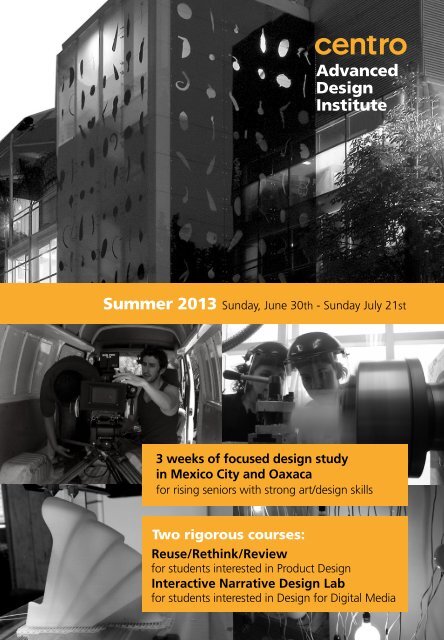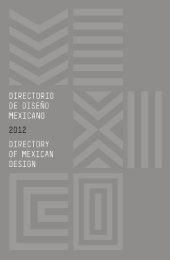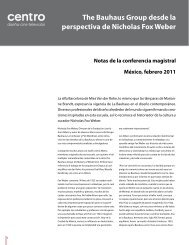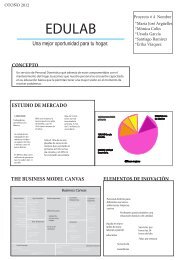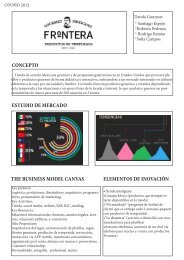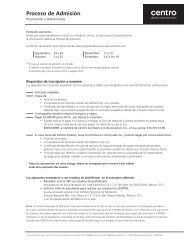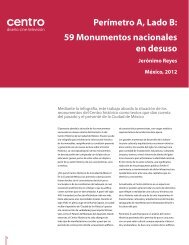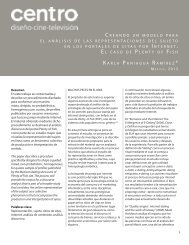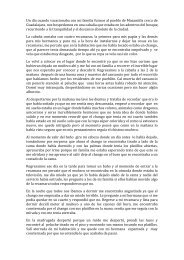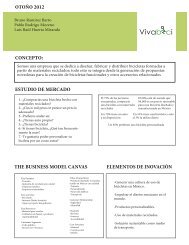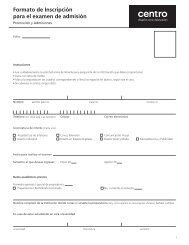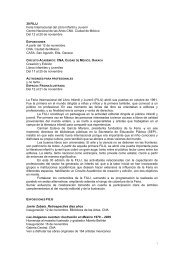Download Brochure - Centro
Download Brochure - Centro
Download Brochure - Centro
You also want an ePaper? Increase the reach of your titles
YUMPU automatically turns print PDFs into web optimized ePapers that Google loves.
Advanced<br />
Design<br />
Institute<br />
Summer 2013 Sunday, June 30th - Sunday July 21st<br />
3 weeks of focused design study<br />
in Mexico City and Oaxaca<br />
for rising seniors with strong art/design skills<br />
Two rigorous courses:<br />
Reuse/Rethink/Review<br />
for students interested in Product Design<br />
Interactive Narrative Design Lab<br />
for students interested in Design for Digital Media<br />
33
Advanced<br />
Design<br />
Institute<br />
CADI summer 2013 Sunday, June 30th - Sunday July 21st<br />
Contents<br />
3<br />
4<br />
7<br />
15<br />
17<br />
19<br />
23<br />
27<br />
Why study design at CENTRO in Mexico?<br />
CADI: CENTRO Advanced Design Institute<br />
Course descriptions<br />
Faculty Bios<br />
Weekly schedule<br />
Day in the life<br />
Campus and facilities in Mexico City and Oaxaca<br />
CADI Staff<br />
Housing Meals and transportation in Mexico City and Oaxaca<br />
Mexico City and Oaxaca<br />
Cultural experiences and partnerships<br />
Program costs, scholarships & application process<br />
29<br />
General Information<br />
Student conduct<br />
Transcripts and credits<br />
Language and prerequisites<br />
Medical/Health<br />
Passports and travel documents
Why<br />
study design<br />
at CENTRO<br />
in Mexico City?<br />
2
CENTRO College for Design,<br />
Media and Film<br />
CenTro is a uniquely modern institution. It is the only independent art or design college<br />
in north America started in the 21st century and the only one focused exclusively on<br />
design, media and film. Created by and for today´s designers, we are pioneers and offer<br />
an innovative and highly relevant curriculum with a strong emphasis on entrepreneurial<br />
thinking. our faculty members are first-and-foremost practicing designers with active<br />
careers in their respective fields. We are a private, sustainable, socially responsible<br />
enterprise, dedicated to creating a positive impact through our work.<br />
In only eight years, CenTro has become recognized as the pre-eminent design university<br />
in Mexico. our students and alumni are winning awards nationally and internationally.<br />
With over 1,000 students enrolled in eight undergraduate and graduate programs<br />
CenTro continues to grow. We have broken ground on construction of our new<br />
campus which will increase our space threefold. In June of 2014 we will move to our<br />
new campus when we celebrate our ten-year anniversary.<br />
CenTro is more than a design university: we are a dynamic platform for research,<br />
exhibitions, conferences, workshops and collaborative projects focused on design,<br />
media and film. CenTro links its students to a global professional and academic network.<br />
A broad range of partnerships, collaborations and specific programs with national<br />
and international institutions generate a multitude of opportunities. our platform<br />
is increasingly international in focus and scope, and our faculty and staff have been<br />
educated in different parts of the world. We are expanding CenTro into a multi<br />
campus design platform with campuses in different parts of the world, including in<br />
north America.<br />
CADI: Focused and rigorous courses taught at college level<br />
Like most colleges, CenTro has a Continuing education department offering a<br />
wealth of courses complementing our degree program courses. Unlike most US<br />
pre-college programs, however, our CADI program is not administered through<br />
Continuing education. This program is organized directly by the design departments.<br />
The department directors have developed the curriculum and will be co-teaching<br />
the courses with other CenTro faculty. These are rigorous and focused college-level<br />
courses, geared towards advanced rising high school seniors only. This is not a generic<br />
portfolio development summer program. The application and selection process is<br />
competitive, and only students with strong art/design skills will be admitted.<br />
3
CADI: CENTRO Advanced Design Institute<br />
CADI is<br />
• A rigorous and focused 3-week intensive summer design experience.<br />
• For students interested in Product Design or Design for Digital Media.<br />
• Taught in English, by CENTRO department directors and senior faculty.<br />
• Open only to rising seniors with strong art/design skills.<br />
• For ambitious high school students who want to be challenged.<br />
• Highly selective in its admissions process.<br />
• Focused for 2 weeks in Mexico City and 1 week in Oaxaca.<br />
CADI Summer 2013 Course offerings<br />
Students will choose one of the following design courses:<br />
Reuse/Rethink/Review –for students interested in product design.<br />
Interactive Narrative Design Lab –for students interested in digital media.<br />
June 30 - July 21, 2013 -3 weeks & 3 college credits<br />
The three-week Advanced Design Institute will allow you to focus in-depth on your<br />
course subject. each course consists of 75 contact hours (in-class instruction), and<br />
25 hours of independent studio/lab time. You are expected to work hard, develop<br />
a much better understanding of your design field and create some strong pieces to<br />
add to your portfolio. Most importantly, we will help you strengthen your conceptual<br />
skills and hone your personal voice as a designer.<br />
CenTro is very much about cross-disciplinary and interdisciplinary collaborations.<br />
Teamwork is a major part of design these days, and we encourage collaboration on<br />
project components between students in both CADI courses.<br />
The last Saturday of the program we will host a Showcase to exhibit your final project.<br />
Your final project, however, will only be a part of the outcome of your three-week course.<br />
In addition to showcasing your products/pieces, you will design the actual exhibit, and<br />
design and fabricate the supporting exhibit materials. The Product Design students will<br />
even design and fabricate the packaging with which to ship their products home.<br />
Class size<br />
Classes will be no larger than18 students. each course will be team-taught by two<br />
CenTro faculty with help from a teaching assistant and a lab technician.<br />
4
We will also have a number of designers join us for pertinent workshops and lectures.<br />
In this setting, you are guaranteed individual instruction and attention from our faculty.<br />
Since your student peer group will be comprised of students who are just as serious<br />
and hard working as you, you will learn a lot from each other as well.<br />
Spanish language & culture immersion<br />
You are in Mexico and although all classes will be conducted in english, why not<br />
improve your Spanish language skills and learn more about Mexican culture? It will<br />
make your time in the city that much more enjoyable, and Spanish is an eminently<br />
useful language. It is the language with the second largest number of speakers, after<br />
Mandarin and before english. You will attend an immersion Spanish language and<br />
culture class, which will meet for 75 minutes after lunch three or four days a week,<br />
depending on the week. We will offer 3 groups, each offered at a different level based<br />
on your skills, including a special section for students who are already fluent in Spanish.<br />
College Credits<br />
Upon successful completion of the CADI program you will receive an official CenTro<br />
transcript and be awarded three college credits, which can potentially be applied to<br />
future undergraduate studies at CenTro or elsewhere.<br />
Costs and Fees<br />
The total tuition and fees for the CADI program is US$2,400. These fees include<br />
all required art supplies and materials. You do not need to purchase any additional<br />
materials for your classes.<br />
A limited number of scholarships are available towards the US$2,400 tuition cost.<br />
These scholarships can cover up to full tuition and are based on the overall merit of<br />
your application and demonstrated financial need.<br />
room and board for double occupancy is US$1,250, for single occupancy it is $1,650.<br />
5
Reuse/Rethink/Review<br />
A pivot to the design process:<br />
Imagining new functions for existing forms.<br />
Taught by the Director of Product Design at CENTRO, Sebastián Ocampo.<br />
This intensive 3-week course will focus on the concepts of reusing design tools and<br />
rethinking the design process. Students will be presented with ten plaster molds<br />
designed to make existing objects and challenged to reuse them to create new products<br />
based on personal ideas. Through drawing, 3D modeling and reverse engineering,<br />
students will visualize how to combine parts of existing ceramic elements with wood<br />
and other materials, to create new forms and functions. Students will use the high<br />
tech 3D modeling and prototyping facilities at CenTro and an artisanal ceramics<br />
workshop in the city of oaxaca as their laboratory and production platforms. The course<br />
will emphasize product design sketching, model making and digital fabrication and will<br />
push students to develop their own voice. Students will create a logbook related to<br />
their personal experience and will produce sketches, drawings, digital images, and a<br />
final functional product. Students will also design how to exhibit their final product(s)<br />
and design and fabricate the packaging with which to ship these products home.<br />
Sebastián Ocampo<br />
An Anglo-Mexican designer, Sebastián ocampo completed his studies at the national School of<br />
Decorative Arts in Paris (enSAD). In 2000, he received the “LABeL VIA” for his collaboration with<br />
CLP Marqueteire, and participated in numerous exhibitions such as the “Art Deco” show at the<br />
Museo Franz Mayer and “18 ans: 18 chaises” at the French Cultural Center in Damascus, Syria.<br />
outstanding examples of his professional activities are the work done for the VIA (Association for<br />
the Appraisal of Innovation in Furniture), the magazine Intramuros, the Furniture Salon in Paris,<br />
the Fund for the Promotion of Arts and Crafts and the French embassy in Mexico. Sebastián has<br />
been the Director of the Product Design department at CenTro since our beginning in 2004.<br />
Francisco Torres<br />
Is a Spanish-Swiss industrial designer who studied at eCAL (University of Art and Design of<br />
Lausanne) where he earned a masters degree and taught design. He has worked with Jorg Boner<br />
(Zurich), Atelier oi (neuveville), Stephen Burks (new York) and was a taught with ronan Bouroullec<br />
at eCAL. Moreover, he has worked for the luxury market LVMH desarollando projects, Coty Prestige<br />
and Donna Karan. Francisco has received the Swiss national Design Award, the Design Award at<br />
the Design Biennial of Saint-etienne, and the Award of excellence from eCAL. He has also been<br />
nominated for recognition by the Design report, and the raymond Loewy Foundation.<br />
7
To give you a taste, this is what your second week in this course<br />
will look like: (All weekly schedules and more course details can be found on the CADI website)<br />
Time/day Sunday Monday Tuesday Wednesday<br />
7:30 - 8:30 AM<br />
9:00 - 12:00 AM<br />
12:15 - 1:00 PM<br />
1:15 - 2:30 PM<br />
2:45 - 5:45 PM<br />
6:15 - 7:30 PM<br />
8:00 - 10:00 PM<br />
10:30 PM<br />
11:30 PM<br />
12:00 PM<br />
Bfast in Hotel<br />
Travel to oaxaca<br />
Lunch TBD<br />
Dinner TBD<br />
Check in with PArA´S<br />
Lights out<br />
Bfast in Hotel<br />
PD studio work<br />
Lunch in Hotel<br />
Spanish/Culture<br />
PD studio work<br />
Dinner in Hotel<br />
Independent studio time PD<br />
Check in with PArA´S<br />
Lights out<br />
Reuse/Rethink/Review | A day in the life<br />
Bfast in Hotel<br />
PD studio work<br />
Lunch TBD<br />
Spanish/Culture<br />
PD studio work<br />
Dinner in Hotel<br />
Independent studio time PD<br />
Check in with PArA´S<br />
Lights out<br />
every day in your course will be different, but this will give you a sense of what one<br />
of your days will be like:<br />
After working in Mexico City for a week on sketching, building mock ups, and<br />
modeling in SolidWorks you will have decided what parts of the black clay molds<br />
you will be using for your individual projects. on our first day in oaxaca we will start<br />
with breakfast at the hotel–perhaps with atole, or agua de Jamaica as well as a cup of<br />
the great local coffee. We will then travel for 15 minutes by van to the Plaza Artesenal<br />
de Barro negro in San Bartolo Coyotepec. Master craftsman Javier Mateos Calderón<br />
will give you an introduction to the clay tradition in their area and his own family<br />
history related to this activity. Javier and his craftsmen will then demonstrate how<br />
to use the molds effectively and work with the clay to achieve the various finishes<br />
Bfast in Hotel<br />
PD studio work<br />
Lunch TBD<br />
Cultural Activities<br />
in oaxaca<br />
Dinner TBD<br />
Cultural Activities<br />
in oaxaca<br />
Check in with PArA´S<br />
Lights out<br />
8
Time/day Thursday Friday Saturday<br />
7:30 - 8:30 AM<br />
9:00 - 12:00 AM<br />
12:15 - 1:00 PM<br />
1:15 - 2:30 PM<br />
2:45 - 5:45 PM<br />
6:15 - 7:30 PM<br />
8:00 - 10:00 PM<br />
10:30 PM<br />
11:30 PM<br />
12:00 PM<br />
Bfast in Hotel<br />
PD studio work<br />
Lunch in Hotel<br />
Spanish/Culture<br />
PD outside work<br />
Dinner in Hotel<br />
PD studio work<br />
Check in with PArA´S<br />
Lights out<br />
Bfast in Hotel<br />
PD studio work<br />
Lunch in Hotel<br />
Spanish/Culture<br />
Cultural Activities in oaxaca<br />
Dinner in Hotel<br />
Check in with PArA´S<br />
Lights out<br />
Bfast in Hotel<br />
PD studio work<br />
Cultural Activities in oaxaca<br />
Dinner TBD<br />
Independent studio time PD Free time<br />
Check in with PArA´S<br />
Lights out<br />
that are possible with the material. We will then break for lunch at one of the local<br />
tianguis in town. After lunch you will work with the craftsmen and begin work with<br />
this unique clay, using the traditional methods just explained and demonstrated. You<br />
will pour the liquid clay into your molds and be able to start to confirm the feasibility<br />
of your design proposals.<br />
At the end of the day we will take the van back to our hotel. After some time<br />
to clean-up and rest we will explore the city of oaxaca on foot and get a tour of<br />
the Cathedral of our Lady of the Assumption. We will eat dinner at one of the<br />
restaurants on the Zócalo and perhaps you will try one of the famous moles or even<br />
the chapulines (fried grasshoppers with chile).<br />
PD class<br />
30 hrs/wk<br />
Spanish class<br />
5 hrs/wk<br />
Independent studio<br />
6 hrs/wk<br />
Workshops<br />
2.5 hrs/wk<br />
9
Interactive Narrative Design Lab<br />
Taught by the Director of Design for Digital Media at CENTRO, Manuel Alcalá.<br />
Students in this intensive 3-week course will be engaged in a series of projects focused<br />
on the use of digital tools to capture, process, create and distribute moving images<br />
and sounds in multiple interactive platforms. The course will follow the production<br />
rhythm of a professional interactive studio, which will have as its laboratories the vast<br />
megalopolis of Mexico City and the eclectic mix of modernity and tradition of the city<br />
of Oaxaca. Workshops will include digital filmmaking and animation, circuit-bending,<br />
videomapping, and the appropriation of social media and web platforms. Students will<br />
participate in several group projects, but will produce a highly personal body of work.<br />
At the end of the course students will showcase their process and final project, and will<br />
create and design their exhibition/delivery environment.<br />
Manuel Alcalá<br />
Manuel graduated with a bachelor’s degree in Film and Television from Boston University and later<br />
did his masters in Media Design at the Art Center College of Design in Pasadena, California. He<br />
has extensively promoted audiovisual media through projects such as the independent videoclub<br />
“Videodromo”, and the outdoor projections of “CINEabierto”. He has received support from<br />
IMCINE for screenwriting and project development, and was selected in the Talent Campus<br />
Guadalajara. He also founded JUDOmedia and the Public Workshop, offices that promote and<br />
create, through conferences, labs and workshops, design production focused mainly on visual<br />
arts and multimedia. He is currently developing projects for TABLOIDE (tabloide.mx), research<br />
studies and interactive content production and was involved with the production of OFFF in<br />
Mexico City this past October. Manuel has been Director of Design for Digital Media -one of our<br />
newest programs, for two years.<br />
Leslie García<br />
Leslie García’s work explores the fusion process between art and technology, using techniques<br />
such as the production of virtual tools, development of electronic prototypes, audio production,<br />
net art pieces design and visual generative codes. She co-founded DreamAddictive electronic<br />
media collective, in Tijuana Mexico 2003- 2010. She has exhibited her work in individual and<br />
group shows, and in various festivals. She has collaborated with: Media Lab Prado, Museo de<br />
Arte Reina Sofía, Eyebeam, O1SJ, Museum of Latin American Arts, Piksel Festival, Ars Electronica,<br />
<strong>Centro</strong> Cultural de España, Public Art Lab Berlin, NOMAD Center for Media Research, Museum<br />
of Contemporary Art in Szczecin, Transitio_MX and others. She recently received grants from,<br />
FONCA (Jóvenes Creadores, Multimedia category, 2009 and 2011) and CENTRO MULTIMEDIA<br />
2010. Leslie has been teaching at CENTRO since 2010. http://lessnullvoid.cc/content/en/<br />
11
12<br />
To give you a taste, this is what your second week in this course<br />
will look like: (All weekly schedules and more course details can be found on the CADI website)<br />
Time/day Sunday Monday Tuesday Wednesday<br />
7:30 - 8:30 AM<br />
9:00 - 12:00 AM<br />
12:15 - 1:00 PM<br />
1:15 - 2:30 PM<br />
2:45 - 5:45 PM<br />
6:15 - 7:30 PM<br />
8:00 - 10:00 PM<br />
10:30 PM<br />
11:30 PM<br />
12:00 PM<br />
Bfast TBD<br />
Cultural Activities<br />
in Mexico City<br />
Lunch TBD<br />
Cultural Activities<br />
in Mexico City<br />
Dinner TBD<br />
Visiting Artists/PArA´S/<br />
Alumni workshops<br />
Check in with PArA´S<br />
Lights out<br />
Interactive Narrative Design Lab | A day in the life<br />
every day in your course will be different, but this will give you a sense of what one<br />
of your days will be like:<br />
Bfast in Hotel<br />
DDM classroom work<br />
Lunch at CenTro<br />
Spanish/Culture<br />
DDM outside work<br />
Dinner in Hotel<br />
Independent studio time<br />
DDM<br />
Check in with PArA´S<br />
Lights out<br />
Bfast in Hotel<br />
DDM classroom work<br />
Lunch at CenTro<br />
Spanish/Culture<br />
DDM outside work<br />
Dinner in Hotel<br />
Independent studio time<br />
DDM<br />
Check in with PArA´S<br />
Lights out<br />
The first part of our transmedia project will be to explore and document some of the<br />
unique spaces and improbable characters of Mexico City. The first few days we will<br />
plan, discuss and prepare in order to develop a more thorough understanding of our<br />
subjects and audience. A visiting lecturer will speak to us about interface and<br />
its crucial role in a multiplatform narrative. We will view and analyze interactive<br />
documentaries online, and decide which aspects appeal to our own work as media<br />
designers. We will conduct a workshop on how to use digital tools for capturing<br />
video, audio and geolocations, and you will learn how to use tools like openStreet<br />
Maps to incorporate interactive maps into your narrative.<br />
on our first Wednesday, with this knowledge under our belt, we will venture into<br />
Mexico City with the photographer Mark Powell as our guide. Mark has made a career<br />
Bfast in Hotel<br />
Travel to Puebla<br />
Lunch TBD<br />
Cultural Activities in Puebla<br />
Dinner TBD<br />
Travel to oaxaca<br />
Check in with PArA´S<br />
Lights out<br />
12
Time/day Thursday Friday Saturday<br />
7:30 - 8:30 AM<br />
9:00 - 12:00 AM<br />
12:15 - 1:00 PM<br />
1:15 - 2:30 PM<br />
2:45 - 5:45 PM<br />
6:15 - 7:30 PM<br />
8:00 - 10:00 PM<br />
10:30 PM<br />
11:30 PM<br />
12:00 PM<br />
Bfast in Hotel<br />
DDM outside work<br />
Lunch TBD<br />
Spanish/Culture<br />
DDM outside work<br />
Dinner in Hotel<br />
DDM outside work<br />
Check in with PArA´S<br />
Lights out<br />
Bfast in Hotel<br />
DDM outside work<br />
Lunch TBD<br />
Spanish/Culture<br />
Cultural Activities<br />
in oaxaca<br />
Dinner in Hotel<br />
Independent studio time<br />
DDM<br />
Check in with PArA´S<br />
Lights out<br />
Bfast in Hotel<br />
DDM outside work<br />
Lunch TBD<br />
Cultural Activities<br />
in oaxaca<br />
Dinner TBD<br />
Free time<br />
Check in with PArA´S<br />
Lights out<br />
of documenting unusual spaces and characters in urban settings from Detroit to<br />
Mexico City. He will share his work (www.markalor.com) and brainstorm with us<br />
over breakfast and coffee at Hotel Polanco. We will then journey through Mexico<br />
City’s subway system, the second largest in north America. Mark will guide<br />
us in his approach to meeting people, talking with them about their lives and<br />
neighborhood, and creating interesting portraits. How do you tell a visual story?<br />
How do you capture and show what you see? We will use our digital tools for<br />
capturing these places, people and encounters. We will break for lunch at a local<br />
tienda, and discuss our progress and experiences. After lunch we will continue<br />
our exploration and capture more images, sounds and video. Around 3 PM we<br />
will return to CenTro with our collected images and documentation to process<br />
our material. After a workshop on video formats and storage protocols, each<br />
student will have a space to present the material they captured. We will break<br />
for dinner and end the day with a shared installation experience of our interactive<br />
documentary of the day on the CenTro terrace.<br />
DDM class<br />
27 hrs/wk<br />
Spanish class<br />
5 hrs/wk<br />
Independent studio<br />
6 hrs/wk<br />
Workshops<br />
2.5 hrs/wk<br />
13
Campus and facilities<br />
in Mexico City and Oaxaca<br />
CENTRO Campus<br />
CenTro’s campus is located in Lomas de Chapultepec, a residential neighborhood in<br />
the northwestern part of Mexico City (in Mexico it is known as the Distrito Federal,<br />
or DF for short.) CenTro’s main building -designed by world-renowned Mexican<br />
architect enrique norten, blends exterior and interior spaces and takes advantage of<br />
Mexico City’s temperate climate. The building has 5 floors of departmental studio<br />
facilities, open studios, computer labs, small lecture spaces, a media center, and a<br />
café serving lunch, snacks and coffee. Most facilities will be available to the CADI<br />
students.<br />
Campus & City Safety<br />
CenTro has a safe college campus. Access to our building is monitored 24/7 by<br />
security guards and access is restricted to current students and staff with valid CenTro<br />
ID cards. You will be able to work in an environment where you feel safe and secure.<br />
our summer program students will be supervised 24/7 by CADI and CenTro staff,<br />
whether they are in our studio facilities, our residence hotel, in transit between<br />
buildings, or on one of our many cultural excursions.<br />
Facilities at CENTRO in Mexico City:<br />
Product design students will have access to everything from architectural drafting<br />
tables, to a CnC router, laser cutter, 3D Printers, and a fully equipped shop for wood,<br />
metal and plastics fabrication. All studios have designated studio technicians who<br />
can advise and assist students with their fabrication processes. Students will also<br />
learn to work with 3D modeling in SolidWorks as part of their projects.<br />
Design for digital media students will have designated priority access to our large<br />
multi-use open film studio with 40 ft. ceilings and movable walls. You will have<br />
access to the film equipment and editing suites of our Film and TV program and<br />
CenTro’s Media Lab. In the Media Lab you can work with microprocessors, various<br />
sensors, projectors and electrical materials to construct physical interfaces. our<br />
computer labs are equipped with Macintosh computers with After effects, Final Cut<br />
Pro, and similar software programs. CenTro is sponsored by SonY ALPHA, which<br />
is providing us with several models of their latest Digital SLr cameras, which we will<br />
use throughout the course.<br />
15
Facilities in Oaxaca City<br />
For our Interactive Narrative Design Lab students:<br />
During our 5-day stay in oaxaca we will capture the sights and sounds in and around<br />
the city of oaxaca. We will also make extensive use of the facilities at the <strong>Centro</strong><br />
de Diseño de oaxaca (CDo). Located in the former monastery of the 16th Century<br />
Church of Santo Domingo de Guzmán, CDo is the first and only government<br />
sponsored institution to promote design as a strategic tool for fostering social,<br />
economic and culture development in Mexico. CDo will be our onsite laboratory<br />
where we will conduct videomapping workshops and talks with local designers. As<br />
part of our program in oaxaca we will also do a final videomapping showcase on the<br />
façade of the former monastery.<br />
For our Reuse/Rethink/Review students:<br />
During our week-long stay in oaxaca our primary studio facility will be the atelier<br />
Plaza Artesenal de Barro negro in San Bartolo Coyotepec. This is one of several<br />
ateliers using the traditional black pottery technique for which oaxaca is famous.<br />
You will work directly with master craftsman Javier Mateos Calderón and his<br />
assistants to fabricate slip casts of parts of your plaster molds. We will also visit<br />
several other fabrication studios such as the hacienda-studio oax-i-fornia and the<br />
wood fabrication shop Tip Muebles in Ixtlán de Juárez.<br />
For all students:<br />
During our oaxaca stay all students will visit several sites of interest such as the<br />
Textile Museum of oaxaca, the Instituto de Artes Gráficas de oaxaca (IAGo), and the<br />
important archeological site of Monte Albán.<br />
16
CADI Staff<br />
Our CADI staff represents a wonderful mix of US and Mexican expertise.<br />
Ms. Jenny Gifford, program director for CADI.<br />
Ms. Gifford is the Dean of Visual Art at the Dreyfoos School for the Arts in West Palm<br />
Beach, Florida and has over ten years of experience coordinating summer sessions at<br />
the Marie Walsh Sharpe summer art program in Colorado. She holds an MFA degree<br />
in painting from Pratt, exhibits regularly and has supervised high school art students<br />
on trips to France and all over the US for many years. She brings with her a deep<br />
understanding of US high school art students, speaks Spanish fluently and will be a<br />
great asset to the program.<br />
Ms. Andrea García-Cano Turner, residence director for CADI.<br />
Ms. García-Cano Turner holds a bachelor degree in Interior architecture from CEDIM<br />
in Monterrey, Mexico. She studied architecture at Parsons, the New School for Design<br />
and organized trips for Mexican students to study at Parsons, 3rd Ward, FIT and<br />
NYU. She is an assistant for the industrial design degree, works with departmental<br />
alumni and faculty and helps develop new projects. She knows Mexico City well and<br />
is fluent in English and Spanish.<br />
Hans Evers, program assistant for CADI.<br />
Hans Evers is the USA Liaison for CENTRO and the Director of College Advising at<br />
Design and Architecture Senior High School. He is adjunct faculty at the Florida International<br />
University and holds an MFA in Sculpture from the School of the Museum<br />
of Fine Arts, Boston and an MA in Art History from Tufts University. He has 14 years<br />
of admissions experience at MassArt, SMFA Boston, the Maryland Institute College<br />
of Art and the Willem de Kooning Academy in Rotterdam.<br />
We will also have two full-time American PARA’s (Program Assistants/Residence<br />
Assistants) to provide additional supervision and support.<br />
Yarminiah Rosa is a recent graduate from the Cooper Union whose resume includes<br />
a year as Residence Advisor in the Cooper dorms. Yarminiah is fluent in Spanish as<br />
well. Marcello Cunha is graduating from the Maryland Institute College of Art this<br />
May, has served as a teaching assistant/residence counselor in the MICA summer<br />
program for two years, and worked at the Marie Walsh Sharpe summer program as<br />
a resident assistant last year. He speaks fluent Portuguese and is brushing up on his<br />
Spanish. The PARA’s will be an important resource for our CADI students, and will be<br />
able to help resolve most personal issues arising during the program.<br />
17
Housing, meals and transportation<br />
in Mexico City and Oaxaca<br />
Mexico City: living at Hotel Polanco<br />
CenTro does not currently have a residence facility. We will be adding a residence<br />
hall on our new campus, which will open in 2014. For the CADI program in 2013<br />
we will use Hotel Polanco as our residence hotel. Hotel Polanco is a three star hotel<br />
in the upscale Polanco neighborhood about 20 minutes by foot and 10 minutes<br />
by van from CenTro. Students will be able to choose a shared double room, or a<br />
single for an additional charge. our program and residence directors and PArA’s<br />
will also reside in the Hotel Polanco and will be responsible for chaperoning and<br />
managing student activities and the living environment. CADI students will not be<br />
allowed to leave the hotel after curfew and they will be expected to adhere to our<br />
rules of conduct at all times.<br />
Oaxaca City<br />
During our stay in oaxaca City, we will be residing in two different hotels. The hotels are<br />
located five small blocks from each other in the center of the city, close to the Zócalo.<br />
reuse/rethink/review students will reside at Hotel Las Golondrinas from July 7th<br />
through the 15th.<br />
Hotel Las Golondrinas is located in an old casa de vecindad consisting of many smaller<br />
structures around an interior courtyard with lush plantings. rooms are doubles and<br />
triples with simple but tasteful furniture and views of the courtyard. The hotel serves a<br />
simple breakfast in the colorful courtyard Interactive narrative Design Lab students will<br />
reside in Hotel oaxacalli from July 10th through the 15th.<br />
Interactive narrative Design Lab students will reside in Hotel oaxacalli from July 10th<br />
through the 15th.<br />
Hotel oaxacalli is a restored colonial house with rooms on two levels around a<br />
traditional central courtyard. rooms have two double beds, tile floors, and simple<br />
furnishings. The hotel’s restaurant serves freshly prepared oaxacan and French dishes<br />
in the dining area.<br />
19
Meals<br />
All breakfasts and dinners are provided and are included in the total program costs. In<br />
Mexico City, breakfast and dinner are provided either at Hotel Polanco or at the CenTro<br />
campus café. During our time in oaxaca, breakfast will be provided at the hotels. We<br />
will enjoy dinner at local restaurants; these meals will be paid by CenTro.<br />
Students will only be responsible for purchasing their own luncheons.<br />
All meals we provide will include options for vegetarians, but we are not able to provide<br />
vegan options. Students with special dietary needs and/or restrictions must specify these<br />
on the CADI enrollment forms prior to arrival. We will make all efforts to accommodate<br />
your needs, but not all preferences can be accommodated. Students with severe allergies<br />
are encouraged to bring supplemental food items with them. You will also have access<br />
to microwaves and vending machines at CenTro and in the hotels.<br />
Mexico City and oaxaca have earned reputations as great culinary centers. no state in<br />
Mexico compares with oaxaca in the variety of cuisines found within its borders due<br />
to the relative geographic isolation of its people, and the climates in which foods are<br />
produced. oaxaca’s gastronomy is known for its “seven moles,” chapulines, oaxaca<br />
tamales in banana leaves, and tasajo. You have certainly had Mexican food in the US<br />
but you´ll see that is it very different from the food you will have in Mexico. There are<br />
many exciting new types of food for you to try... from fried cactus leaves (nopal frito)<br />
to chapulines con guacamole... that is fried grasshoppers for those who are not fluent<br />
in Spanish. We hope you will be adventurous!<br />
Transportation and Supervision<br />
All transportation in Mexico City is with CenTro vans and our regular certified drivers.<br />
These vans (we refer to them as “ideas in motion”) and drivers are used extensively in<br />
our degree program throughout the year.<br />
Upon your arrival at Benito Juárez International Airport in Mexico City, you will be met<br />
by CADI staff andour PArA’s and will be transported to our residence hotel using our<br />
vans and drivers.We will use these vans for all our local transportation needs –including<br />
your drop-offat the airport at the end of the program and our local excursions. All of<br />
these trips and each individual van will at all times be supervised and chaperoned by<br />
our PArA’s, CenTro staff and/or faculty.<br />
For our major trip to oaxaca we will rent two large tour buses (one for each course) to<br />
accommodate students, staff and faculty. Students will be supervised by CenTro staff<br />
at all times during these trips as well. In oaxaca we will use transportation organized<br />
through our local partner institution, the <strong>Centro</strong> Diseño oaxaca.<br />
20
Mexico City and Oaxaca<br />
Mexico City and Oaxaca study abroad experience<br />
What is better than combining a rigorous and focused pre-college experience<br />
with an exciting and informative study abroad adventure? And if you want to<br />
study abroad, why travel the well-worn paths to Italy, France and other parts of<br />
europe? Why not visit the largest city in north America and the oldest architectural<br />
structures in Mesoamerica? our program includes numerous cultural excursions<br />
inside Mexico City as well as specific trips and work ‘in situ’ directly related to your<br />
design course. In short, these three weeks will be jam-packed with interesting<br />
experiences and will give you a completely new perspective on your Latin American<br />
neighbor to the south.<br />
Mexico City<br />
Metropolitan Mexico City is, by many accounts, the largest city in the Americas and the<br />
third largest in the world. It is also one of the highest cities in the world at an altitude of<br />
7,200 feet. Mexico City is a fascinating metropolis with a wealth of cultural resources.<br />
It is consistently listed among the top 10 cities to visit in Latin America according to<br />
Travel & Leisure Magazine (ranked # 4 in 2012 and #3 in 2011), and this year, it is<br />
listed as having one of the top 10 bike sharing programs in the world. Mexico City is<br />
a wonderful cacophony of color and sights and a fascinating cultural mix of old and<br />
new. It has been and continues to be a real inspiration for artist and designers. Think<br />
of Diego rivera and Frida Kahlo, and more recently of Gabriel orozco and enrique<br />
norten. Mexico City, is the leading cultural center of Latin America and you will be<br />
surprised by how modern and sophisticated the DF (Distrito Federal) is in terms of<br />
contemporary architecture, art and design. The area of Lomas de Chapultepec where<br />
CenTro is located can be compared to Century City in Los Angeles and the Cuatro<br />
Torres Business Area (CTBA) in the Paseo de la Castellana district of Madrid. Polanco,<br />
the area where Hotel Polanco is located on the other hand, feels very much like the<br />
Upper West Side of Manhattan in terms of scale and neighborly areas with parks full of<br />
parents and kids; and like the Upper east Side in terms of high-end shops, restaurants<br />
and hotels. Mexico City is also home to some of the great museums and sights of<br />
the world. The CADI program will take full advantage of all these resources but we<br />
will also immerse ourselves in the contemporary culture of Mexico City. We will, for<br />
example, attend a soccer match in the estadio Azteca –which is a completely different<br />
experience from going to an American football or baseball game.<br />
23
We will visit many of the museums and modern galleries but will also visit the canals<br />
and ‘chinampas’ of Xochimilco.<br />
For more information on Mexico city’s cultural resources:<br />
http://en.wikipedia.org/wiki/Mexico_city<br />
Oaxaca<br />
The city of oaxaca is the capital and largest city of oaxaca state and is home to the native<br />
Zapotec and Mixtec cultures. In Mexico, oaxaca is known as “the face of the nation.”<br />
A Spanish-colonial city, it represents one of the nation’s richest cultural heritages in art,<br />
food, and textiles, and has one of the most diverse bio-regions anywhere. In 2010,<br />
Travel & Leisure Magazine ranked oaxaca 8th in the world, ahead of Barcelona and<br />
new York, as one of the “World’s Best” top 10 cities to travel to. Lonely Planet ranked<br />
oaxaca as one of its top 10 world food cities and Food and Wine Magazine ranked<br />
oaxaca as one of 20 best-of-the-best of the world’s premier food destinations. Along<br />
with the 2,500-year old archeological site of Monte Alban, oaxaca has been named a<br />
World Heritage Site by UneSCo. oaxaca has developed as a major center for design<br />
and crafts in recent years and is the home of the new <strong>Centro</strong> de Diseño de oaxaca<br />
–the first and only government sponsored institution to promote design as a strategic<br />
tool for fostering social, economic and cultural development. The <strong>Centro</strong> de Diseño de<br />
oaxaca, will be a sponsor and strategic partner with CenTro for our CADI program.<br />
oaxaca city is about a five-hour bus ride from Mexico City. It is a frequent destination<br />
for CenTro faculty and students. All CenTro freshmen enrolled in our mandatory first<br />
year “color” class visit oaxaca. Many of our special projects and workshops take place<br />
in this area and a number of students do their community service projects here. It is a<br />
city and area where CenTro has high visibility and many exciting cultural and artistic<br />
connections. In oaxaca we will visit several fabrication studios such as the haciendastudio<br />
oax-i-fornia and the wood fabrication shop Tip Muebles in Ixtlán de Juárez. We<br />
will also tour the Textile Museum of oaxaca, the Instituto de Artes Gráficas de oaxaca<br />
(IAGo), and of course the important archeological site of Monte Albán.<br />
For more information on Oaxaca’s cultural resources:<br />
http://en.wikipedia.org/wiki/Oaxaca,_Oaxaca<br />
24
Program costs, scholarships<br />
and application process<br />
Course Costs<br />
The total tuition and fees for the 3-week CADI program is US$2,400.<br />
These fees include all required art supplies and materials. You do not need to purchase<br />
any additional materials for your classes.<br />
room and board<br />
• Double occupancy is US$1,250<br />
• Single occupancy is US$1,650.<br />
The room and board fees cover all your expenses in Mexico, including local transport<br />
and museum entrance fees.<br />
The only costs you will incur are your lunches and any personal purchases you may<br />
want to make during your stay. Lunch in the CenTro café or elsewhere costs between<br />
US$5-US$8. Your total cost for the three weeks is approximately $200.<br />
You will also be responsible for your own travel expenses and arrangements to and<br />
from Mexico City. If you book well in advance, your round trip to Mexico City should<br />
cost around US$500.<br />
Summer Precollege Scholarship Awards<br />
A limited number of scholarships are available towards the $2,400 tuition cost. These<br />
scholarships can cover up to full tuition and are based on the overall merit of your<br />
application and demonstrated financial need.<br />
If you are applying for a scholarship, you must also submit a copy of your parent’s most<br />
recent tax returns and pay stubs.<br />
27
Application Procedures & Timeline<br />
We will continue accepting applications through June 1st<br />
on a space available basis!<br />
Admission to the CADI program is highly selective and will be based mostly on the<br />
portfolio you submit.<br />
To be eligible to apply to the CADI program you must be a rising senior when you apply.<br />
Your anticipated year of graduation from high school should be 2014.<br />
To apply, you must submit the following materials by the deadlines specified below.<br />
All materials (including recommendations and transcripts) are submitted electronically<br />
using Slideroom at: http://CENTRO.slideroom.com<br />
1. Completed CADI 2013 application.<br />
2. Application fee.<br />
3. A portfolio of 10 pieces: we suggest that 5 of these should be related to your chosen<br />
design course. (Please refer to the portfolio submission guidelines in the application<br />
instructions on Slideroom for more details on how to format the images of your work).<br />
4. Resume.<br />
5. High school transcript.<br />
6. Your response to our course specific application prompt.<br />
7. One teacher recommendation ––from a teacher in art, design, media or other<br />
discipline related to your design interest.<br />
Timeline WEBSITE)<br />
Due dates<br />
February 27 Applications for the CADI program will be available on line.<br />
April 1 Priority application deadline - application fee of $35<br />
April 15 Notifications –including scholarship offers<br />
will be e-mailed to priority admitted students.<br />
May 10 Notifications –including scholarship offers will be e-mailed<br />
to students who applied by April 30th<br />
May 15 Notifications –including scholarship offers will be e-mailed<br />
to students who applied by May 10th<br />
May 21 Payment deadline for all admitted students<br />
(priority and regular)<br />
May 24 All travel, insurance, and related forms will be<br />
emailed to registered students.<br />
Jun 1 EXTENDED application deadline - application fee of $55<br />
June 3 These forms are due back completed and signed.<br />
If you have not done so yet, you should book your travel<br />
& ensure you have a valid passport.<br />
Sunday June 30th Travel to Mexico City<br />
Sunday July 21st Travel back home.<br />
28
General Information<br />
Student Conduct<br />
The CenTro Advanced Design Institute is designed for independent rising senior<br />
high school students who are mature and will take initiative in and outside of the<br />
classroom. If you and/or your parents are looking for a sheltered and highly structured<br />
environment, this program may not be a good match for you. Please consider this<br />
carefully before applying.<br />
CADI students are expected to maintain the highest standards of personal conduct,<br />
and be respectful of personal and CenTro property and of the rights of other students<br />
and staff. All students participating in CADI must sign and abide by the CADI Code<br />
of Student Conduct and additional program rules, which are sent to all students once<br />
enrolled in the program. For more detailed information please refer to the CADI Code<br />
of Student Conduct on our CADI website.<br />
Transcripts and college credits<br />
Upon successful completion of the CADI program, you will receive an official CenTro<br />
transcript indicating you have earned 3 college credits. CenTro has the highest level<br />
of accreditation with the Mexican Department of education and our transcripts are<br />
recognized and honored all over the world.<br />
Language and prerequisites<br />
All classes are conducted in english and all faculty and staff are fluent english speakers.<br />
There are no prerequisites for the courses in Product Design and Design for Digital<br />
Media. To be eligible to apply you must be a rising high school senior -your expected<br />
year of graduation from High School should be 2014. The application process for<br />
CADI will be selective and will be mostly based on the strength of your portfolio. There<br />
are also no prerequisites for the Spanish Immersion Conversation class. We will offer<br />
three sections to accommodate all levels of Spanish proficiency from first-time learner<br />
through fluent speaker.<br />
29
Health Insurance<br />
CADI students must show proof that they have current health insurance and that this<br />
coverage extends to Mexico during their stay. We recommend you check with your<br />
current medical insurance company whether your coverage applies while traveling in<br />
Mexico. If your insurance does not cover you in Mexico, we require that you secure<br />
additional insurance for the duration of the CADI program<br />
There are many companies, which provide travel insurance and health care coverage<br />
in Mexico.<br />
once you have been accepted and you have registered for the program we will send<br />
mandatory health forms for you to complete and return to CenTro prior to your arrival.<br />
All details pertaining to health and medical insurance will be covered in these forms.<br />
Please refer to the following two sources:<br />
http://travel.state.gov/travel/cis_pa_tw/cis/cis_970.html#insurance<br />
http://traveltips.usatoday.com/health-insurance-travel-mexico-19311.html<br />
Health Medical<br />
CenTro does have its own health center on campus with an on-duty nurse who can<br />
provide immediate care and resolve simple medical issues, including help with the<br />
infamous ‘turista’ stomach ailments. Students are instructed to avoid drinking tap<br />
water or eating foods that could be contaminated and to avoid purchasing food from<br />
street stands, and unreliable restaurants. Despite the best precautions however, some<br />
students will contract a stomach bug. The normal bout with ‘turista’ lasts 1-3 days;<br />
usually Pepto-Bismol and Tylenol are the best sources for relief. CenTro has a contract<br />
with Hospital español, one of the top local hospitals, where we refer students who<br />
cannot be helped effectively by the nurses in our health center. We also have a contract<br />
with a local ambulance service in case of emergencies.<br />
Hospital details<br />
Beneficencia española (Hospital español)<br />
ejército nacional 613, Colonia Granada, México, D.F.<br />
Tel.: (+52-55) 5255-9659 | 5255-9660<br />
emergency: (+52-55) 5255-9645 to 49<br />
Website: www.hespanol.com<br />
30
Passports and travel documents<br />
You will need a valid passport to be able to travel to Mexico. You do not need a special Visa,<br />
or additional paperwork for a three-week stay, and travelling to Mexico is easy and safe.<br />
You will be responsible for booking your own round-trip air transport from your home to<br />
Mexico City. You will book your flight to Benito Juárez International Airport (MeX). Upon your<br />
arrival at the airport, you will be met by CADI staff and our PArA’s and will be transported<br />
to our residence hotel using our CenTro vans and certified drivers. In case of unforeseen<br />
delays or flight changes, we will ensure we have staff at the airport to help you and welcome<br />
you. our program director, and residence director will at all times be reachable via email and<br />
through US cell phone numbers in case you need to communicate last-minute changes to<br />
your arrival time.<br />
When you go through immigration at the airport you will be issued a visitor visa. This is a<br />
loose piece of paper you should keep with your passport. You will be required to return<br />
it at immigration when you leave Mexico. A notarized letter of consent from parent(s) is<br />
required for minors (anyone under the age of 18) traveling alone, with one parent, or in<br />
someone else’s custody. A form letter for parents to use for this purpose will be sent. Please<br />
allow yourself ample time to have the letter notarized. The state department states that a<br />
minor traveling alone or with only one parent should have evidence of the relationship and<br />
permission of the parents or legal guardian not present for the child’s travel. Having such<br />
documentation on hand, even if not required, may facilitate entry and departure. If a child’s<br />
last name is different from that of his/her parents, the student should also bring their birth<br />
certificate or official documents confirming the parent-child relationship.<br />
31
CENTRO College for Design, Media and Film<br />
Gina Diez Barroso de Franklin<br />
PreSIDenT<br />
Abraham Franklin Silverstein<br />
VICe-PreSIDenT<br />
Kerstin Scheuch<br />
GenerAL DIreCTor<br />
Interior Architecture<br />
Beata nowicka<br />
DIreCTor<br />
Film and Television<br />
Jorge Bolado<br />
DIreCTor<br />
Visual Communication<br />
Uzyel Karp<br />
DIreCTor<br />
Product Design<br />
Sebastián ocampo<br />
DIreCTor<br />
Digital Media Design<br />
Manuel Alcalá<br />
DIreCTor<br />
Textile and Fashion Design<br />
Liza niles<br />
DIreCTor<br />
Marketing and Advertising<br />
Federico Antoni<br />
DIreCTor<br />
centro.edu.mx<br />
CADI Partners and Sponsors<br />
ADvISORy BOARD MEMBERS<br />
Alfredo Achar Tussie<br />
Marcos Achar Levy<br />
Carlos Alazraki<br />
Gloria Amtmann<br />
Pedro Aspe<br />
Antonio Cué Sánchez navarro<br />
Alfredo elías Ayub<br />
José ramón elizondo<br />
Adolfo Fastlicht<br />
Andrés Gómez<br />
Marinela S. Lerdo de Tejada<br />
enrique norten<br />
Carlos rojas Mota Velasco<br />
Javier Sordo Madaleno<br />
INTERNATIONAL ADvISORS<br />
red Burns, nY<br />
Dorothy Dunn, nY<br />
Ángel Sánchez, nY<br />
<strong>Centro</strong> de Diseño de Oaxaca<br />
http://cdo.gob.mx/en/
College for Design, Media and Film<br />
Sierra Mojada 415<br />
Lomas de Chapultepec<br />
México, D. F., 11000<br />
centro.edu.mx<br />
Advanced<br />
Design<br />
Institute<br />
centro.edu.mx/CADI


